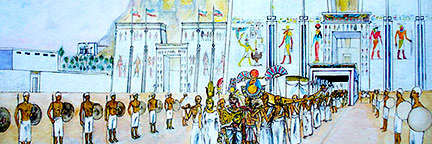
|

The War in Sudan Reaches Meroe (UNESCO World Heritage Site)  War in Sudan: Worries About the National Museum in Khartoum  Sudan and Israel: From Ancient to Modern Times
Art History: Observations on the Deffufas of Kerma , Remarks on Kushite Temples Dated to the Napatan-Meroitic Period, Remarks on Palace Architectures, and Drawing Reconstructions
New article added to the Burials section: The Pyramids (of Sudan) at Monterey Bay Ancient History of Western Sudan by Ibrahim.B.Musa IntroductionWhere is the land of Kush?Kush is located in Northeastern Africa, within the political boundaries of modern Sudan. Alternative Names for Kush:Three terms are used in literature to refer to the land of Kush; these are Ethiopia, ancient Nubia, and recently Sudan. Click here for more on each name. Who are the Kushite?The Kushites are the ancestors of the people of the Nile valley in Sudan today. The people of Kush practiced agriculture along the valley building one of the very early world civilizations, dating back to the rise of the Kerma kingdom in the third millennium BCE. According to the Biblical Table of Nations, the Kushites are the descendants of Ham, the son of Noah. While the Kushites shared their language with the ancient Egyptians, Meroitic emerged later as the official language of the Kushite kingdom. The earliest date associated with a Meroitic writing is the fourth century BCE. On the other hand, Old Nubian is identified with the medieval era and its oldest studied writing dates to the eighth century. While linguists today struggle to interpret and classify Meroitic, precarious linguistic studies classify the modern Nubian language as a Nilo-Saharan language, though some suggest an Afro-Asiatic classification. After the intensified migration of Arab populations into Sudan, starting from the fourteenth century CE, many Arab tribes settled and intermarried with the native populations. As most of the immigrants were men, and since Arabs follow a patrilineal tradition (i.e. the children take the identity of their fathers), a majority of Sudanese today descend from ethnic groups that historically identified as Arab. A reverse scenario is also documented through the Banu Kanz, a historically Arab population who identified with Nubia during the medieval era. Groups of nomads, closely related to the Kushites, have inhabited the eastern and western deserts relying on subsistent agriculture. Th nomads of the east were known to the Kushites as "Meded", to the Egyptians as "Medjay", to the Arabs as "Beja," and to the Romans as "Blemmyes." Since ancient times, the inhabitants of the western deserts have practiced pastoralism, side by side with the Libyans. Intermarriages with other foreigners took place at different times and in other parts of Sudan, which caused the Kushite identity to disappear and the Nubian identity to wither greatly. For example, in the southern region of Darfur, in southwestern Sudan, some of the indigenous nomads had intermixed with West African immigrants, as well as with Arab settlers. A minority of Sudanese today along the Nile still identify as Nubians.Today, the language and culture of the bulk of Sudanese people is obviously an Arabic one. Yet, the physical features and genetics of today's Sudanese population proved to be mainly native. The Anthropological studies of mummies from ancient Sudan and the sharp and clear colored drawings of people found inside Kushite burials that go back as far as 3000 years, prove that the ancient people of Kush and Nubia looked typically like the modern riverine people of Sudan with their dark complexion and curly or wavy hair. |


